The leaves of Plant 51r resemble beetles, but could there be any reason to add a beetle to a section devoted to plants?
It was not unusual for medieval manuscripts to include drawings of reptiles and mammals. Snakes were often drawn alongside plants that had “serpentina” in the name, snakelike roots, or which were believed to cure snake bite. Animals with names similar to plants, like camel and Camelina, were often shown next to one another.
Critters are not uncommon in herbal manuscripts and bestiaries, but they are quite scarce in the plant sections of the VMS. The dragon-like creature that appears to be nibbling on Plant 25v is the exception rather than the norm.
Are There Bugs in the Leaves?
When I first saw Plant 51r, the leaves reminded me of stag beetles, industrious little bugs that use their mandibles like a stag uses its horns, to fight off rivals vying for sexual favors. There are three “legs” on each side, a pair of “mandibles” on the outer end, and a decorative line running down the middle.
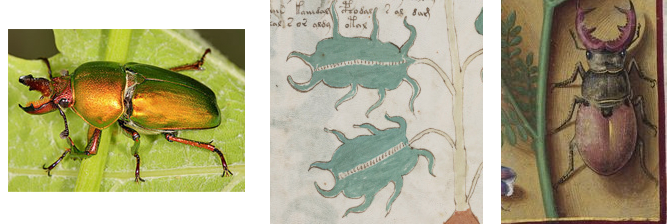
The VMS leaves are reminiscent of beetles, with the correct number of legs and rounded “mandibles” like the clawlike choppers of the stag beetle. The illustration on the right is from an early 16th-century French manuscript that includes many plants and insects accurately drawn from life. Were the VMS leaves meant to represent bugs, or is it a plant with bug-like leaves?
I’m not aware of any plants that have points coming off the leaves that are quite as exaggerated as f51v, and the unpainted line running across the middle looks less like a plant vein than most of the other plants. I’m also not aware of any plant leaves with this basic shape that have distinctively different end-leaflets. As mentioned in the previous blog, the entire plant strikes me as more stylized than naturalistic, with a somewhat anthropomorphic pose.
Would there be any reason to include beetle leaves (or other insect leaves) in a section about plants? Pliny the Elder, who was the inspiration for many medieval herbal manuscripts, mentions that stag beetles were called “lucanus” after a region of Italy in which they were used as amulets, much as the rounder, less fearsome-looking scarab beetles were used in Egypt. In the middle ages, the horns of stag beetles were said to be medicinal.
Maybe the VMS leaves aren’t beetles, maybe they are visual references to some other kind of bug. Ants were commonly included in medieval bestiaries and you would never guess they were ants if they weren’t labeled:
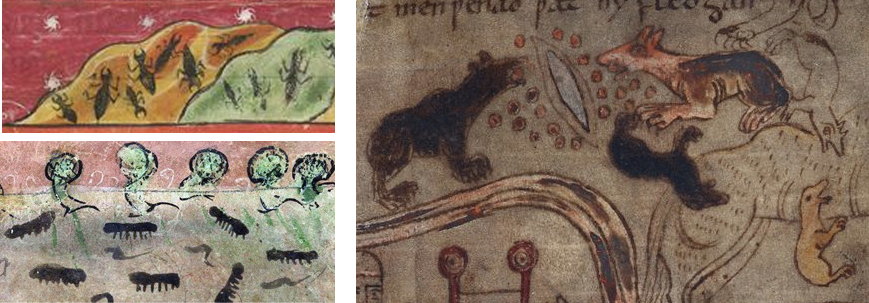
The ants on the top left are missing a pair of legs, but are otherwise fairly recognizable [British Library Harley MS 3244] and are somewhat similar to the VMS “beetle” leaves. The ants below them, from the 13th century, look more like centipedes or caterpillars. Those on the right are fearsome ants, drawn like dogs and bears, and it’s only because of the text that we know that they are ants [BL Cotton MS Vitellius A XV]. Another example (not shown) depicts ants as lunging hounds on leashes. Naturalism was apparently not as important as getting the concept across.
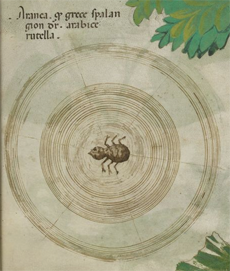 Sloane 4016, a manuscript familiar to Voynich researchers that has good drawings compared to many of its predecessors, includes an image of a spider on a web that suggests the illustrator had very little knowledge of spiders or their webs. The spider is missing a pair of legs and looks more like an ant than a spider. One might speculate that it’s a reference to a spider-like insect that was used to create red dyes, rather than an actual spider, except that it’s labeled Aranea which specifically refers to orb-weaving spiders.
Sloane 4016, a manuscript familiar to Voynich researchers that has good drawings compared to many of its predecessors, includes an image of a spider on a web that suggests the illustrator had very little knowledge of spiders or their webs. The spider is missing a pair of legs and looks more like an ant than a spider. One might speculate that it’s a reference to a spider-like insect that was used to create red dyes, rather than an actual spider, except that it’s labeled Aranea which specifically refers to orb-weaving spiders.
Decorative Veins
The leaf dots on Plant 51r are out of character with most of the other plant drawings. Many of the VMS leaves are well drawn, accurately recording leaf margins and veins (note that this is my opinion, not everyone agrees), but this one resembles a zipper-like decorative element from a painting or piece of medieval stumpwork. It’s like the pattern on a rubricated initial or a caterpillar’s back.
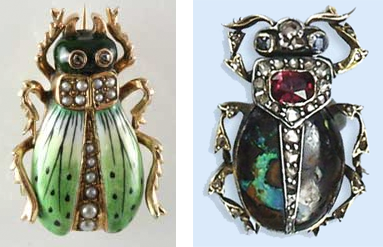
Beetles have inspired art for thousands of years and often include decorative elements down the middle of the back. Left, antique pin courtesy of Ten Two Three. Right, jewelry by Court Jeweler House of Bolin, est. 1791.
If the leaf were a reference to ants, it would be hard to explain the line. But beetles have wings under a protective cover and when the two sides are slightly spread, a textural difference emerges.
Jewelers often use this anatomical feature as inspiration for adding a row of precious stones down the center of the back. Given that scarabs and other forms of beetles have been used in jewelry for thousands of years, it would not be surprising to see a decorative element added to the back of something based on a beetle.
Possible Plant IDs
What if the resemblance to a stag beetle is unintentional? Can the VMS plant be identified without resorting to mnemonics or stylistic similarities to non-botanical elements? Are there plants with bug-like leaves with exaggerated leaflets?
There are many plants with irregular, lacinated, or ruffled leaf margins, but I’m not aware of any that look like the leaves of f51r if (this is an important “if”) you narrow them down to plants that have flowers with a bulbous section under the petals, as well.
Plants with Pinwheel Flowers and Beetle-Like Leaves
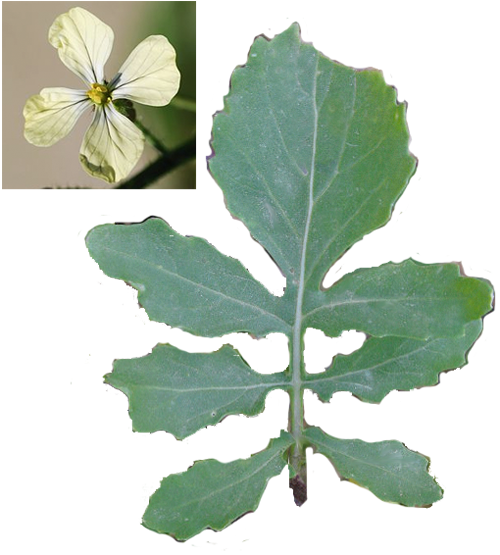 Perhaps the leaves of rocket (Eruca sativa), or one of its relatives, might qualify. Rocket leaves are similar to dandelion, but more deeply indented and with fewer leaflets. The vein down the middle is a little lighter than the rest of the leaf. It has 4-petaled flowers that look like pinwheels with a slightly bulbous attachment to the stem and a narrow tap root.
Perhaps the leaves of rocket (Eruca sativa), or one of its relatives, might qualify. Rocket leaves are similar to dandelion, but more deeply indented and with fewer leaflets. The vein down the middle is a little lighter than the rest of the leaf. It has 4-petaled flowers that look like pinwheels with a slightly bulbous attachment to the stem and a narrow tap root.
Rocket, also known as salad mustard or arugula, is widely used as food and was also a medicinal herb in the middle ages. It’s a Eurasian plant common to the Mediterranean that now grows worldwide. If sufficiently stylized, a rocket leaf might resemble 51r, especially if you consider that deer like to walk along and munch off the ends of the leaves, leaving them concave instead of convex.
Groundsel (Senecio) might qualify, but the leaves are longer, with more indentations, and the flowers don’t look like pinwheels. Silene or Saponaria have the right kind of flowers, but the leaves are lanceolate, not at all beetle-like. I glanced at Edith Sherwood’s ID just now, and she has listed sea rocket (Cakile maritima) as a possible ID, but the leaves are quite a bit longer and more narrow than the VMS plant and I think Dame’s rocket (Eruca) is a closer match than Cakile.
What about sound-based mnemonics? There is a plant called beetle daisy, but it doesn’t look like 51r and it’s from S. Africa. Another called beetleweed with rounded leaves grows in the eastern U.S. Trying to search for plants with the names of insects is almost impossible unless you’re willing to sift through millions of insect pictures to find one or two plant names in each language.
Summary
The leaves of Plant 51r may have nothing to do with beetles, but I thought it worth exploring because the morphological resemblance is pretty strong and the more stylized a plant, usually the more likely it is to be associative rather than naturalistic. It isn’t the most exaggerated VMS plant, there are some that are even wilder, but it is pretty animated and that adds to both its mystery and its charm.
J.K. Petersen
© Copyright 2017 J.K. Petersen, All Rights Reserved

Hmm, those leaves are tricky. It’s clear that they have been somewhat molded into the shape of an insect, which as so often leaves us wondering what the real thing looked like. Considering the way the stalk is drawn and colored, it could even be some kind of tree.
The leaves do look like “antlered” beetles, though I’d have no idea what to make of that. In my opinion the line through the middle is too rectangular to just represent the opening where the wings are visible. I guess it could mean its own thing.
Just off the top of my head, the insect could be a termite, some of them have mandibles of the appropriate size. In that case, the rectangle in the middle could symbolize a piece of wood affected by them:
http://www.topbest.ph/wp/wp-content/uploads/termite-inspection.jpg
Some woods are known to be naturally resistant to termites, and apparently some are even toxic to them.
If the plant is not meant to be a tree, it could be something like a herb with termite-repellant properties.
The line down the middle is very zipper-like, not quite insect-like, as you mention. I suppose it could be a cross between insect part and plant vein, but I’m at a loss as to give a good explanation for the vein or anything else. It’s more animated and puzzle-like than many of the plant drawings.
Zoom in on this Scorpio, it’s got the same spine. And the right amount of legs. Antidote plant?
http://gallica.bnf.fr/ark:/12148/btv1b6000961g/f36.item.zoom
Check out this page
https://en.wikipedia.org/wiki/Diplotaxis_(plant)
and look at the entry for Diplotaxis simplex – a scarab beetle!
In contrast to your experience, there was a list of 34 plants and one beetle.
Once again, I think you are onto something.
Diplotaxis tenuifolia (perennial wall rocket) could be your plant – else why name a plant genus after a beetle?
I’ve been paying attention to this and have since seen many occasions where the spines of critters were indicated with this exact pattern. It seems to be more of an artistic convention than a reflection of reality. “Critters” include all manner of insects, but also other small animals like crustaceans etc.
Just to say, there is a strong indication of mnemonics in the leaves here.